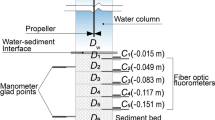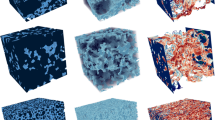Abstract
We investigate the importance of selecting two different methodologies for the determination of hydraulic conductivity from available grain-size distributions on the stochastic modeling of the depth-averaged breakthrough curve observed during a forced-gradient tracer test experiment. The latter was performed in the Lauswiesen alluvial aquifer, located near the city of Tübingen, Germany, by injecting NaBr into a well at a distance of about 50 m from a pumping well. We also examine the joint effect of the choice of the transport model adopted to describe solute transport at the site and the way the spatial distribution of porosity is assessed. In the absence of direct measurements of porosity, we consider: (a) the model used by Riva et al. (J Contam Hydrol 88:92–118, 2006; J Contam Hydrol 101:1–13, 2008), which relates the natural logarithms of effective porosity and conductivity through an empirical, experimentally-based, linear relationship derived for a nearby experimental site; and (b) a model based on a commonly used relationship linking the total porosity to the coefficient of uniformity of grain size distributions. Transport is described in terms of a purely advective process and/or by including mass exchange processes between mobile and immobile regions. Modeling of flow and transport is performed within a Monte Carlo framework, upon conceptualizing the aquifer as a random composite medium. Our results indicate that the model adopted to describe the correlation between conductivity and porosity and the way grain-sieve information are incorporated to depict the heterogeneous distribution of hydraulic conductivity can have relevant effects in the interpretation of the data at the site. All the conceptual models employed to describe the structural heterogeneity of the system and transport features can reasonably reproduce the global characteristics of the experimental depth-averaged breakthrough curve. Specific details, such as the peak concentration and the time of first arrival, can be better reproduced by a double porosity transport model when a correlation between conductivity and porosity based on grain size information at the site is considered. The best prediction of the late-time behavior of the measured breakthrough curves, in terms of the observed heavy tailing, is offered by directly linking porosity distribution to the spatial variability of particle size information.














Similar content being viewed by others
References
Archie GE (1950) Introduction to petrophysics of reservoir rocks. Bull Am Assoc Petrol Geol 34(5):943–961
Beyer W (1964) Zur Bestimmung der Wasserdurchlässigkeit von Kiesen und Sanden aus der Kornverteilung. Wasserwirtschaft-Wassertechnik (WWT) 14:165–168 Berlin (Verlag für Bauwesen)
Boman GK, Molz FJ, Boone KD (1997) Borehole flometer application in fluvial sediments: methodology, results and assessment. Groundwater 35(3):443–450
Carman PC (1937) Fluid flow through granular beds. Trans Inst Chem Eng 15:150
Carman PC (1956) Flow of gases through porous media. Butterworths Scientific Publications, London
Carrier WD (2003) Goodbye, Hazen; Hello, Kozeny-Carman. J Geotech Geoenviron Eng 129:1054–1056
Dagan G (2004) On application of stochastic modeling of groundwater flow and transport. Stoch Env Res Risk Assess 18:266–267. doi:10.1007/s04477-004-0191-7
Deutsch CV, Journel AG (1998) GSLIB geostatistical software library and user’s guide, 2nd edn. Oxford University Press, New York
Fernàndez-Garcia D, Illangasekare TH, Rajaram H (2005) Differences in the scale dependence of dispersivity and retardation factors estimated from forced-gradient and uniform flow tracer tests in three-dimensional physically and chemically heterogeneous porous media. Water Resour Res 41(3). doi:10.1029/2004WR003523
Freeze RA, Cherry JA (1979) Groundwater. Prentice Hall Inc., Englewood Cliffs, New Jersey
Gégo E, Johnson G, Hankins M (2001) An evaluation of methodologies for the generation of stochastic hydraulic conductivity fields in highly heterogeneous aquifers. Stoch Env Res Risk Assess 15:47–64
Gómez-Hernández JJ, Journel A (1993) Joint simulation of multiGaussian random variables. Geostatistica Tróia ‘92, vol 1. Kluwer Academic Publishers, pp 85–94
Haggerty R, Fleming SW, Meigs LC, McKenna SA (2001) Tracer tests in fractured dolomite 2. Analysis of mass transfer in single-well injection-withdrawal tests. Water Resour Res 37(5):1129–1142
Harbaugh AW, Banta ER, Hill MC, McDonald MG (2000) MODFLOW-2000, the U.S. geological survey modular ground-water model––user guide to modularization concepts and the ground-water flow process. U.S. Geological Survey Open-File Report 00-92, 121 pp
Hess KM, Wolf SH, Celia MA (1992) Large-scale natural gradient tracer test in sand and gravel, Cape Cod, Massachusetts 3. Hydraulic conductivity variability and calculated macrodispersivities. Water Resour Res 28(8):2011–2027
Hu BX, He C (2006) Using sequential self-calibration method to estimate a correlation length of a log-conductivity field conditioned upon a tracer test and limited measured data. Stoch Env Res Risk Assess 21:89–96
Hu BX, Meerschaert MM, Barrash W, Hyndman DW, He C, Li X, Guo L (2009) Examining the influence of heterogeneous porosity fields on conservative solute transport. J Contam Hydrol doi:10.1016/j.jconhyd.2009.06.001
Huang C, Hu BX, Li X, Ye M (2008) Using data assimilation method to calibrate a heterogeneous conductivity field and improve solute transport prediction with an unknown contamination source. Stoch Environ Res Risk Assess. doi:10.1007/s00477-008-0289-4
Hufschmied P (1986) Estimation of three-dimensional statistically anisotropic hydraulic conductivity field by means of single well pumping tests combined with flowmeter measurements. Hydrogeologie 2:163–174
Kasenow M (2002) Determination of hydraulic conductivity from grain size analysis. Water Resources Publications, LLC, Highlands Ranch, CO, pp 47–84
Kozeny J (1927) Uber kapillare leitung des wassers im boden: Sitzungsber [On capillary flow of water in soil], vol 136. Sitz Ber Akad Wiss Wien, Vienna, pp 271–306
LaBolle EM, Fogg GE, Tompson AFB (1996) Random-walk simulation of transport in heterogeneous porous media: local mass-conservation problem and implementation methods. Water Resour Res 32(3):583–593
Martac E, Ptak T (2003) Data sets for transport model calibration/validation, parameter upscaling studies and testing of stochastic transport models/theory. Report D16 of project “stochastic analysis of well-head protection and risk assessment—W-SAHaRA”, EU contract EVK1-CT-1999-00041. Dipartimento Ingegneria Idraulica, Ambientale, Infrastrutture Viarie, Rilevamento, Politecnico di Milano, Milan, Italy
McQueen J (1967) Some methods for classification and analysis of multivariate observations. 5th Berkeley symposium on mathematics, statistics and probability, vol 1. pp 281–298
Molz FJ, Morin RH, Hess AE, Melville JG, Güven O (1989) The impeller meter for measuring aquifer permeability variations: evaluations and comparison with other test. Water Resour Res 25:1677–1683
Morin RH (2006) Negative correlation between porosity and hydraulic conductivity in sand-and-gravel aquifers at Cape Cod, Massachusetts, USA. J Hydrol 316:43–52
Neuman S (2004) Stochastic groundwater models in practice. Stoch Env Res Risk Assess 18:268–270. doi:10.1007/s00477-004-0192-6
Neuman SP, Blattstein A, Riva M, Tartakovsky DM, Guadagnini A, Ptak T (2007) Type curve interpretation of late-time pumping test data in randomly heterogeneous aquifers. Water Resour Res 43:W10421. doi:10.1029/2007WR005871
Odong J (2007) Evaluation of empirical formulae for determination of hydraulic conductivity based on grain-size analysis. Journal of American Science 3(3):54–60
Ptak T, Teutsch G (1994) A comparison of investigation methods for the prediction of flow and transport in highly heterogeneous formations. In: Dracos TH, Stauffer F (eds) Transport and reactive processes in aquifers. Balkema, Rotterdam, pp 157–164
Ptak T, Piepenbrink M, Martac E (2004) Tracer tests for the investigation of heterogeneous porous media and stochastic modelling of flow and transport––a review of some recent developments. J Hydrol 294:122–163
Rehfeldt KR, Hufschmied P, Gelhar LW, Shafer ME (1989) Measuring hydraulic conductivity with the borehole flowmeter. EPRI Top Rep EN-6511. Electr Power Res Inst, Palo Alto, CA, USA
Riva M, Guadagnini L, Guadagnini A, Ptak T, Martac E (2006) Probabilistic study of well capture zones distribution at the Luswiesen field site. J Contam Hydrol 88:92–118
Riva M, Guadagnini A, Fernandez-Garcia D, Sanchez-Vila X, Ptak T (2008) Relative importance of geostatistical and transport models in describing heavily tailed breakthrough curves at the Lauswiesen site. J Contam Hydrol 101:1–13
Sack-Kühner B (1996) Einrichtung des Naturmeßfeldes “Lauswiesen Tübingen”, Erkundung der hydraulischen Eigenschaften, Charakterisierung der Untergrundheterogenität und Vergleich der Ergebnisse unterschiedlicher Erkundungsverfahren. Diplomarbeit im Fachbereich Geowissenschaften der Eberhard-Karls-Universität Tübingen, 96 Abb., 21 Tab., 147 S
Salamon P, Fernàndez-Garcia D, Gómez-Hernández JJ (2006) A review and numerical assessment of the random walk particle tracking method. J Contam Hydrol 87(3–4):277–305
Salamon P, Fernàndez-Garcia D, Gómez-Hernández JJ (2007) Modeling tracer transport at the MADE site: the importance of heterogeneity. Water Resour Res 43:W08404. doi:10.1029/2006WR005522
Sanchez-Vila X, Guadagnini A, Carrera J (2006) Representative hydraulic conductivities in saturated groundwater flow. Rev Geophys 44:RG3002. doi:10.1029/2005RG000169
Stauffer TB, Manoranjan VS (1994) The use of grain-size analysis with limited field data to study hydraulic conductivity variability. Avation Space Environ Med 65(5):A125–A130
Vuković M, Soro A (1992) Hydraulics and water wells: theory and application. Water Resources Publications, Highlands Ranch, CO, USA. 1143 Hydrogeology
Wen XH, Gómez-Hernández JJ (1996) The constant displacement scheme for tracking particles in heterogeneous aquifers. Ground Water 34(1):135–142
Winter CL, Tartakovsky DM, Guadagnini A (2003) Moment differential equations for flow in highly heterogeneous porous media. Surv Geophys 24(1):81–106
Wolf SH, Celia MA, Hess KM (1991) Evaluation of hydraulic conductivities calculated from multiport-permeameter measurements. Ground Water 29(4):516–525
Acknowledgements
Financial support by Marie Curie Initial Training Network “Towards Improved Groundwater Vulnerability Assessment (IMVUL)” is gratefully acknowledged. Additional funding from the Politecnico di Milano (GEMINO, Progetti di ricerca 5 per mille junior) is acknowledged. We are grateful to Eugeniu Martac and Thomas Ptak for sharing with us data from the Tübingen site.
Author information
Authors and Affiliations
Corresponding author
Rights and permissions
About this article
Cite this article
Riva, M., Guadagnini, L. & Guadagnini, A. Effects of uncertainty of lithofacies, conductivity and porosity distributions on stochastic interpretations of a field scale tracer test. Stoch Environ Res Risk Assess 24, 955–970 (2010). https://doi.org/10.1007/s00477-010-0399-7
Published:
Issue Date:
DOI: https://doi.org/10.1007/s00477-010-0399-7




